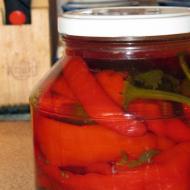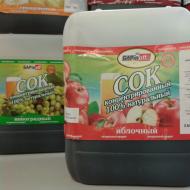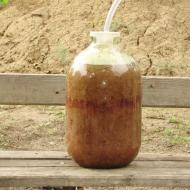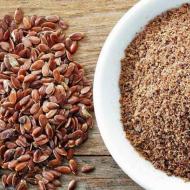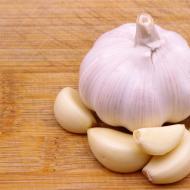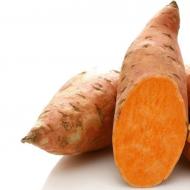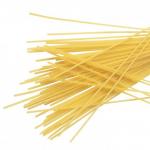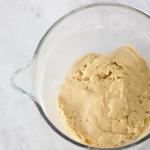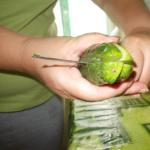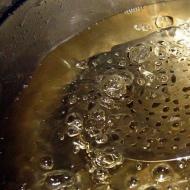
Jalapeno Pepper Recipe. Jalapeno peppers: benefits, harms, recipes. The use of pepper in cooking
Today, there are many ways to preserve chili peppers and each recipe is unique, so it is quite difficult to choose a specific one. What is useful chili pepper and why should it be canned?
Peculiarities
Chili pepper has the following properties:
- strengthens the immune system due to the high concentration of strengthening and rejuvenating vitamins;
- promotes the production of endorphins;
- helps to strengthen blood vessels, due to the content of micro and macro elements.
The need for conservation
Our people have a tradition that is relevant to this day: to make canned preparations for the winter. Chili peppers must be preserved for the reason that, thanks to this process, its taste becomes softer and more tender, and all useful things are preserved for a long time, since a product that was grown in the season, and not in greenhouse conditions, has the largest amount of all kinds of vitamins and minerals.
Fiery pepper in ketchup marinade Torchin
A recipe perfect for spicy food lovers.
Required Ingredients:
- dried chili - 200 g;
- vinegar - 2 tsp;
- sugar - 1 tsp;
- salt - to taste;
- clove of garlic;
- ketchup Torchin;
- vinegar 9%;
- bay leaf - 2 leaves.

Cooking:
- Due to the fact that dried pepper has a bitter taste, it must be soaked in water for several hours.
- After the product is soaked, it is lowered into boiling water and boiled there for 3 minutes.
- While the pepper is cooking, you need to prepare the marinade, it can be made from ketchup torchin and vinegar in equal proportions (the amount of sauce should be proportional to the amount of pepper).
- The next step is to put all the seasonings and garlic on the bottom of the jar.
- Next, boiled pepper is added, which is poured with marinade, and the jar itself is rolled up.
Peppers prepared according to a similar recipe do not require any special storage. It is enough to put the jar with the product in the refrigerator and in a few days it will be ready for use. Such preservation can be used in the preparation of stews or Italian pasta with meat.
dill recipe
A simple recipe without the use of sauce.
Required Ingredients:
- chilli;
- water - 2l.;
- salt and sugar - to taste;
- vinegar - 1 tbsp;
- fresh dill;
- horseradish;
- several cloves of garlic.

Cooking:
- Peppers must be thoroughly washed and cut off the tails, and the seeds left.
- Then the peppers are laid out in an even layer in seaming jars, which were previously washed and dried.
- The next step is to add dill, horseradish, peeled garlic and pepper to the jar.
- Next, you need to boil the water, pour it into jars covered with a lid, leave for 15 minutes.
- The water is then carefully drained back into the pot and brought back to a boil in a few minutes. Next, you need to turn off the gas and immediately add vinegar to the water.
- Now you need to completely pour the prepared peppers with the marinade.
To be sure, you can turn the cans over, and so that they do not accidentally explode, you can wrap them up. It should also be remembered that this recipe contained information about the amount of ingredients needed for the marinade per 3 liter jar, but mostly they are preserved for the winter in smaller jars (cans up to 1 liter are approximately used). Therefore, you need to divide the products depending on the volume of the can.
Caucasian chili peppers: a quick and easy recipe
Required Ingredients:
- water - half a liter;
- ground cilantro - 20g;
- fresh herbs - 20g;
- mint - 10g;
- garlic;
- sugar and salt - to taste;
- coriander - 10g;
- allspice in peas - to taste;
- vinegar - tsp;
- bay leaf and some cloves.

Cooking:
- The first step is to wash all the ingredients and put them to boil on fire.
- After a few minutes, vinegar is added to the pan and the ingredients continue to boil for about 5 minutes.
- Then the marinade is filtered and infused.
- Peppers are laid out in a pre-boiled jar and poured with marinade, the jar is rolled up.
In order to make the dish sweeter, you can use apple cider vinegar instead of regular vinegar.
Pickled jalapeno: just as good as canned chili
Required Ingredients:
- jalapeno pepper;
- water - 500 ml;
- garlic;
- salt and sugar - to taste.

Cooking:
- The pepper is peeled and cut into slices.
- Next, the garlic must be poured with water and boiled for several minutes. After that, sugar and salt are added there, the resulting solution must be boiled for 5 minutes.
- Now the peppers need to be put in a jar and pour them with marinade.
- Banks roll up and wait for the onset of winter.
Jalapeno is characterized by the fact that its taste in the process of eating gradually turns from sweet to spicy. This feature is preserved during conservation.
Chili pepper with honey
Required Ingredients:
- jalapeno;
- chilli;
- a few tablespoons of honey;
- salt - to taste;
- water - 500 ml;
- apple cider vinegar 9% - 2 tbsp;
- garlic.

Cooking:
- Peppers should be cut into half rings and set aside.
- Salt, garlic, apple cider vinegar, honey are poured into boiling water. Marinade boils no more than 5 minutes.
- Peppers are laid out in a sterilized jar and poured with marinade.
- The bank is spinning.
Thanks to the mixture of chili peppers and jalapenos, a very tasty and unusual winter salad is obtained.
Hot pepper for the winter (video)
Chili pepper is a very unusual and healthy product that can be prepared in various ways. Every winter, you can pamper yourself and loved ones with a spicy and incredibly tasty side dish. In addition, such a twist can be used in the preparation of meat dishes: it will give the necessary sharpness and specific taste.
Jalapeno is a variety of vegetable pepper with an original name and unusual taste. This pepper has an average sharpness (from 2500 to 10000 points on the Scoville scale). But depending on the conditions in which it grows, the degree of its burning can be very high.

Appearance
Jalapeno is a type of chili pepper. It belongs to the genus Capsicum, a type of vegetable Pepper. A plant up to 1 meter long, which ripens from 25 to 35 small peppers weighing about 50 grams, reaching a length of up to 9 cm. The fruits are green, and by the end of the season they turn red.

Where does it grow
Mexico is the world leader in the cultivation of jalapeno peppers. Here it can be found with different names: cuaresmeños, chiles gordos or huachinangos. Rich harvests of jalapenos are collected in states such as Veracruz, as well as Chihuahua. In smaller volumes, it is cultivated in several other places: the state of Jalisco and Chiapas, the state of Nayarit, Sonora and Sinaloa. By the end of the last century, the Americans also took up the cultivation of this pepper, allocating a space of 22 square meters for this purpose. km, the key areas of which are the western region of Texas and the southern part of New Mexico.

Spice production method (collection)
Jalapeno peppers take 2 to 3 months to fully mature. Harvesting begins when the pods turn green. The reddening of the pods signifies the end of the season. Red pods have a lower value than green pods. But there is a use for them too: drying, smoking or using as the main ingredient for the preparation of the Mexican chipotle seasoning.

Collection and processing of fresh pods is carried out only with gloves, as contact with the fruit may cause skin irritation. Fresh peppers should be stored in an airtight glass container in the refrigerator for no more than two weeks. For long-term storage of jalapeno peppers, you can use the quick freeze method. When dried, it is perfectly stored in a tightly closed glass container and always in a dark place. If necessary, dry fruits can be crushed.

How to choose
When buying fresh jalapeno peppers, you need to pay attention to the appearance of the pods: they should be even and smooth. Also on sale jalapeno is found in oil and in dried form. Red pods can be purchased dried, pickled, and also as a ready-made chipotle seasoning.


Characteristics
- when eaten in the oral cavity, a feeling of warmth or strong burning sensation appears;
- the presence of capsaicin in the composition of pepper determines its sharpness;
- in terms of pungency, jalapeno is ahead of the well-known chili pepper;
- the tissue that holds the seeds in the pod is the most pungent part of the pepper. Cleaning the fruit from these tissues will reduce its sharpness and neutralize the sour taste.

Nutritional value and calories
Nutritional value of fresh jalapeno, 100g:
In addition, the pepper contains the following components: water - 89 gr.; ash - 4.5 gr.; dietary fiber - 2.6 gr.; saturated fatty acids - 0.1 gr.; unsaturated fatty acids - 0.05 gr.
Chemical composition
By eating jalapeno peppers for food, a person receives invaluable help for the body, since it contains a lot of components that are essential for health and well-being, such as: B vitamins, vitamins - A, E, K, C, PP, beta-carotene.
Minerals:
- sodium, potassium, magnesium;
- phosphorus, calcium, copper;
- iron, manganese, zinc, selenium.
As well as other elements:
- sugar;
- essential oils;
- piperidine;
- capsanthin;
- chavicin;
- capsorubin;
- carotene.

Beneficial features
The variety of useful substances included in the jalapeno causes a wide range of effects on the human body and its internal processes.
Due to its composition, pepper has the following properties:
- antimicrobial;
- painkiller;
- immuno-strengthening;
- antiviral;
- antidepressant;
- stimulating the process of digestion.

Harm
Excessive consumption of jalapeno, like any other hot pepper, in any form can cause gastrointestinal disturbances.
Contraindications
- gastrointestinal disorders;
- various diseases of the kidneys and liver;
- stomach ulcer;
- allergic reactions and individual intolerance.
Application
In cooking
Mexicans know a lot about pepper. That is why their cuisine is replete with "hot" dishes, the preparation of which is not complete without various varieties of hot peppers. In Mexico, jalapeno is used as the main ingredient in the traditional onion seasoning, which is a must on any table. The preparation of a wide variety of spices, sauces and snacks is also not complete without its use. And of course, another popular dish of this country is jalapeno stuffed with meat.



Jalapeno has long been an indispensable component of the first and second courses, because it goes well with many types of meat and some types of fish. The famous Mexican dish nachos is a delicious snack consisting of corn chips with various additives, which are served with different types of sauces. Peppers are also used in recipes for stews, salads, and cheese dishes. Residents of some regions have mastered recipes for making jalapeno desserts: jelly, jam, drinks.


Chipotle
Chipotle, a classic Mexican condiment, is made from overripe red jalapenos. For several days, the fruits are smoked on wood smoke. Chipotle is used as an ingredient that improves the taste of various sauces, soups, meat and vegetable dishes.

We suggest you cook one of the popular Mexican snacks according to the following recipe.
Guacamole with jalapeno peppers
To prepare guacamole, you need to chop 50 grams of onions, 4 green tomatoes, 3 fresh jalapeno peppers and 10 grams of cilantro. Then add the juice of one lime and puree the resulting mixture in a blender.
You will also need 5 peeled, pitted avocados. They must be cut into large pieces and sprinkled with lime juice to avoid browning. Next, the avocado is mixed with cooked vegetable puree. Salt and pepper are added to taste. In order for the salad to acquire a richer aroma and taste, it is necessary to cover it with a lid and leave it in the refrigerator for 2-3 hours.

You can learn more about jalapeno peppers from the following video of the Live Healthy!
In medicine
The use of fresh jalapeno peppers, as well as in the form of tinctures, is successfully used to improve the general condition of the body and get rid of various ailments. Its healing properties are effective for:
- prevention of cardiovascular diseases;
- lowering cholesterol in the blood;
- protect body cells from the action of toxins;
- acceleration of metabolism;
- improving the functioning of the digestive system;
- blood thinning and lowering high blood pressure;
- stimulating the process of digestion and improving appetite;
- normalization of intestinal microflora;
- strengthening the walls of blood vessels;
- stimulating the production of endorphins, which positively affect mood and increase stress resistance;
- fight insomnia;
- improvement of vision;
- maintaining healthy skin and hair.

Varieties
In Mexico, you can find several varieties of jalapenos that differ from each other in the appearance of the pods. The peludo variety has long thick pods, espinalteco produces pointed fruits, and morita is elongated and short.



cultivation
When growing jalapeno peppers, a number of mandatory rules must be observed at all stages: from the moment the seeds are planted to the harvest.

Planting seeds
For sowing seeds, it is convenient to use a tray with a lid. Seeds are planted to the required depth and covered with a small amount of soil, and the tray can be closed with a lid.
Until sprouts appear, the tray must be kept in a dark place with minimal light penetration, constantly maintaining the required level of soil moisture.
When sprouts appear, the tray opens and moves to the windowsill from the south. Regular watering must be continued. For even vertical growth of plants, the tray periodically turns in the right direction.

When 2-4 leaves appear, the seedlings dive, and the plants are transplanted into larger pots. As the seedlings grow, the volume of the pots should increase, since fruiting directly depends on this.

15-20 days after the last frost, the plants are planted in open ground, the temperature of which should be from 15 ºС and above. For landing, you need a site illuminated by the sun for at least 6 hours a day.

Care
Seedlings are planted in holes twice the size of the pots. Optimum planting depth is achieved when the soil is at leaf level. The distance between plants should be at least 30 centimeters, and the rows should be located at a distance of 60 centimeters from each other.
During the vegetative stage, fertilizers are used in which the nitrogen content is higher and the phosphorus content is lower. When flowering, on the contrary, there should be less nitrogen and more phosphorus. 14 days before harvesting, it is necessary to wash the fertilizers with a strong jet of water and a special solution that removes salts from the soil.

Regular watering and the absence of weeds will ensure good pepper growth. 20 days after planting, mulching is performed. If the pepper bushes have become large, then it is advisable for them to build a support.
Collection
Harvested after an average of three months. Pods that are green in color and have a very pungent taste are considered ripe. Ripe pepper easily breaks off the branch. Brown lines that look like stretch marks are also a signal that the crop needs to be harvested. To make the pepper sweeter, you can leave it on until the pods are completely red, which are great for drying.

The climate of temperate latitudes allows growing jalapenos only in closed greenhouses and greenhouses. Also, pepper can grow in residential apartments. Jalapeno is a perennial plant with a pronounced period of winter dormancy. In the cool season, the plant should be kept indoors at a temperature of 16 to 20 ° C. In summer - at a temperature of about 25 ° C. Jalapeno loves light and moisture. Their absence in the required amount leads to the fall of flowers and fruits. However, over-watering can be detrimental to this plant, as it can cause root rot.

In 1982, American astronauts took a green jalapeno on a space flight, as this pepper is one of the most popular in the United States. That is why jalapeno is the first pepper to go into space as a favorite condiment of American astronauts.
The variety of pepper with the original name jalapeno is in great demand in Mexico. In local cuisine, the vegetable is an indispensable ingredient in the most popular dishes and sauces. Green fruits are pickled, fried, stuffed. After studying the recipes, spicy lovers can treat themselves and seven savory dishes at home.
Jalapeno peppers are a variety of the famous chili. It is considered medium spicy in comparison with its counterparts. Acceptable pungency and unusual taste have made it very popular in the cuisine of South American countries. The leader in the cultivation of spicy fruits is Mexico. Pepper is also cultivated in the southern states of the United States, but in much smaller volumes.
Jalapeno ripening is quite long. To get delicious green fruits, you should wait 2-3 months. By the end of the season, the vegetable turns red and loses its value. However, in this form, pepper is used. It is dried, smoked and prepared with the famous Mexican chipotle seasoning.
Attention! The collection and processing of jalapenos must be done with gloves. Direct contact of the fruit with the skin causes itching and redness.
The plant itself reaches a height of 1 m. On each bush, 25-30 fruits ripen. Collect peppers in stages. Hot commodity - with green skin, 8-9 cm in length.
Several varieties are cultivated in Mexico:
- Peludo - the fruit of the plant is thick and long;
- Espinalteco - distinguished by pointed, elongated pods;
- Morita - the fruits are not long and not thick.
The most burning part of the pod is the so-called middle, to which the seeds are attached. When using the fruit in cooking, this place is removed.
Plucked fruits quickly wither, losing their taste. The best storage method is freezing. Suitable for drying. Dehydrated jalapeno peppers are placed in a glass container and placed in a dark place.
The benefits and harms of burning fruits
In its composition, jalapeno pepper contains a lot of substances useful for humans:
- A whole complex of vitamins: K, E, PP, C, group B.
- Many minerals: potassium, sodium, iron, phosphorus, zinc, selenium.
- Carbohydrates, proteins, essential oils.
These elements have a beneficial effect on the internal processes occurring in the human body. The spicy product has an analgesic effect, helps to cope with the attack of viruses and bacteria. Pepper is especially valuable during periods of epidemics of influenza and other acute respiratory viral infections.
By consuming jalapeno peppers regularly, you can expect the following benefits:
- Improvement in the work of the digestive tract. Substances contained in sharp fruits increase the secretion of juices that digest food, suppress harmful microflora, and eliminate flatulence.
- Stimulation of motor activity of the intestine relieves the body of toxins, feces.
- Reducing the level of unhealthy fraction of cholesterol in the blood. Jalapeno is an excellent condiment for fatty meats and fish.
- Normalization of metabolism. Pepper promotes moderate weight loss.
- Prevention of premature aging. Substances from green fruits protect cells from free radicals.
- A burning vegetable accelerates the blood, cheers up, for which it is considered an antidepressant.
Attention! The sharpness of pepper depends entirely on the area in which and under what conditions the fruits were grown.
But despite the abundance of positive qualities, not everyone can include jalapenos in the diet. Pepper is undesirable for the elderly, children. You can not eat spicy dishes with the following diseases and conditions:
- Various inflammations in the oral cavity (stomatitis, tonsillitis, tonsillitis, etc.).
- An ulcer on the mucous membrane of the stomach or duodenum.
- Inflammatory processes in the intestines.
The vegetable serves as an excellent addition to both first and second courses, but a person who is unaccustomed to such a cuisine needs to be extremely careful with it.
Known Recipes
Residents of South America often harvest pickled spicy fruits. Such jalapeno peppers are used as an additive or as an independent snack.
Prepare canned food quickly and easily.
- In selected specimens (2 kg), tails are removed.
- Pepper cut into small (1.5 cm thick) circles.
- Boil 1 liter of water. There add 1.5 cups of sugar and 2 tbsp. l salt. Add 0.5 cups of vinegar (9%) and 1 cup of vegetable oil.
- Pepper rings are immersed in boiling water and left in this form for a quarter of an hour.
- With a slotted spoon or tongs, circles are taken out and filled with prepared containers.
- It remains only to pour the fragrant preparation with marinade and roll it up.
 Chipotle
Chipotle From overripe peppers, which is noticeable by the red skin, they prepare one of the most popular seasonings in Mexico - chipotle.
To complete the recipe, you will need 1 kg of fruit and a little patience. Peppers are well washed and soaked for 6-9 hours. After that, the pods are sent to the grill, where they are smoked over smoldering coals for 3-4 hours, regularly turning over. The softened and smoky product is suspended in a dry place. Ready chipotle is added to sauces, soups, stews, vegetables.
Attention! Jalapenos should be preserved with a minimum set of spices. So the pepper will not lose its special taste and aroma.
Jalapeno is a vegetable that contains many useful substances. Seasoning from it will increase the appetite and bring real pleasure to fans of Mexican cuisine and not only.
What dishes do you use jalapenos in?
Pickled Peppers: Video
One of the most popular varieties of hot peppers is the hot Jalapeno. This vegetable is popular in many countries, but became famous thanks to Mexican cuisine. It got its name from the small settlement of Xalapa, near which there is a huge plantation of 160 square meters. km, breeding this particular species. Mexico is still the main exporter of Jalapeno to this day. But recently it has been grown in the USA and Spain.
There is a misconception that Jalapeno is one of the hottest peppers in the world. But it's not. The pungency index of this vegetable varies from 3 to 8 thousand on the Scoville scale. And this is the average. Green fruits are much superior in quality to red ones, therefore, in most cases, they dry and harvest "unripe" peppers.

Jalapeno is quite a healthy vegetable, because it contains:
- vitamins A, C, K, B1, B9, B5,
- iron,
- calcium,
- phosphorus,
- linoleic acid,
- magnesium,
- carotene and carotidin.
And this is not a complete list. Due to such a rich composition, the use of Jalapeno has a great effect on the state of the body:
- improves metabolism,
- promotes the production of endorphins
- helps to cope with insomnia,
- increases appetite,
- strengthens the walls of blood vessels,
- beneficial effect on the circulatory system,
- lowers blood pressure
- improves skin condition,
- increases stress resistance.
But do not consume Jalapeno in large quantities. After all, its pungency can harm the mucous membranes of the stomach. It is forbidden to add this vegetable to the menu for people suffering from diseases of the gastrointestinal tract, liver and kidneys, as well as for individual intolerance.
The use of pepper in cooking
Almost every Mexican dish is prepared with Jalapenos. Its sharpness gives a piquant taste to any meat, fish or vegetable delicacy. At the same time, stuffed peppers are considered the best treat. Without this dish, it is impossible to imagine more than one Mexican celebration.
This vegetable makes savory snacks and sauces, and Nachos is the most famous of them. To prepare this dish, the fruits are filled with cheese or minced meat. There is another famous delicacy of Mexican cuisine - Chipotle. To prepare it, red peppers are smoked with wood smoke. Due to this, the fruits begin to “smell” with the aroma of chocolate with an admixture of tobacco, but taste like prunes.
No matter how surprising it sounds, various jams and jellies are prepared from Jalapeno. And some chefs even glaze this pepper in chocolate. In the states, this vegetable is often consumed with crackers. Italians add fruits to their pizza. In European countries, pickled peppers are preferred. So it is added to various side dishes and meat dishes. Jalapeno is often a staple in savory soups and salads.
pickled pepper
Canned Jalapeno practically does not lose its taste and useful qualities, but only if it is cooked correctly. Therefore, to avoid mistakes, use our recipe.
For cooking you will need the following products:
- Jalapeno pepper - 2 kg,
- sugar - 1.5 cups,
- water - 1 liter,
- table vinegar - 0.5 cups,
- sunflower oil - 1 cup,
- salt - 2 tbsp. spoons.
Before you start harvesting the product for the winter, prepare 3 cans, one liter in volume. To do this, wash the dishes, and then sterilize them for 10 minutes in a water bath. You should also do the same with seaming lids. All work with pepper is best done with gloves, because its juice is quickly absorbed into the skin, causing a burning sensation.
Cooking process:
1. Wash the pepper and peel it from the stalks. If you want a less spicy dish, then remove the seeds. Cut the vegetable into slices, half a centimeter thick.
2. Prepare the marinade. To do this, pour water into a small saucepan, add salt, sugar and mix well.
3. Put the marinade on the fire and bring to a boil.
4. Pour in vinegar and vegetable oil.
5. Put the Jalapeno in the marinade and blanch for 5-7 minutes.
6. Arrange the pepper in jars, fill with broth and roll up with sterilized lids.
7. Place the blanks upside down.
8. Banks are recommended to be wrapped for several hours until completely cooled.

Sauce Guacamole
This delicacy is very much appreciated in Mexico. Of course, in our conditions, some products from this recipe are considered rare, but if you wish, you can buy them at any large supermarket.
Product set:
- Avocado - 2 ripe fruits,
- Lime - 1 pc.,
- Jalapeno - 2 pcs.,
- Half a lemon
- Garlic - 5 cloves,
- Cilantro - a small bunch.
- gucomole sauce
Cooking process:
1. Cut off the stalk from the pepper, and remove the seeds.
2. Remove the pit from the avocado.
3. Clean the garlic.
4. Squeeze out the juice from the lemon and lime.
5. We put all the products in the blender bowl and, after salting to taste, grind them well until a homogeneous mass.
6. Add finely chopped cilantro to the finished sauce and mix the mixture.
If you wish, you can “ennoble” the taste of the dish with sour cream, tomatoes, olive oil, spices and seasonings. In general, do not be afraid to show imagination. This sauce goes well with meat and fish dishes, and is also a great addition to chips.
Jalapeno peppers add a splash of flavor to any dish. At the same time, the process of pickling jalapeno peppers is distinguished by a variety of brine recipes: from classic to spicy-sweet. It goes well with meat dishes, fish and vegetables. And it will provide sauces with a spicy spicy taste. A distinctive feature is that pepper during the heat treatment process retains most of its valuable qualities.
Jalapenos are widely used in Mexico. It belongs to the hottest variety of peppers. For harvesting, dense, slightly immature pods are often chosen. Cut into rings, it can be eaten neat or used to decorate dishes.
Pepper is rich in valuable components. Contains vitamins B group, A, C, K. Of the micro and macro elements present: phosphorus, calcium and iron. The vegetable is the leader in the content of linoleic, ascorbic acids, carotidine and carotene.
Selection and preparation of the main ingredient
The preparation of the main component depends on the form in which it will be marinated:
- Mostly dense fruits are selected. Sort the pods, remove spoiled or damaged ones.
- Cut off the stalks. If you need to reduce the spiciness of the finished dish, it is recommended to remove the seeds.
- If pickled whole, the stalk is not removed, but a small incision is made along the fruit so that the pepper does not burst. If pickled in the form of rings, the pod is cut accordingly.
How to pickle jalapeno peppers at home
Pickling for the winter will not be difficult, the main thing is to follow the recommended proportions and cooking technology.
Classic marinade
Pepper in a classic marinade retains its original taste, which is not interrupted by spices and other ingredients.
Required components:
- jalapeno - 17-20 pods;
- granulated sugar - 90-95 g;
- salt - 55 g;
- vinegar (wine white) - 230 ml;
- water - 240 ml;
- garlic - 2 cloves.
Action plan:
- Wash the pods, cut the stalks. Cut the fruits into rings.
- Peel the garlic, cut and put in a bowl. Pour in water, add salt and sugar. Boil the brine.
- Put the chopped vegetable, wait for it to boil, pour in the vinegar.
- Using a slotted spoon, place the rings in a clean, sterilized container. When it is full, pour in the brine and close tightly.

Sweet spicy marinade
Jalapeno prepared in such a marinade has a richer, spicier taste and aroma. It is used as an appetizer, added to Mexican recipes, or used in sauces.
Required components:
- jalapeno - 5-7 pods;
- vinegar (wine, apple) - 120 ml;
- black and allspice pepper - 4 peas each;
- coriander - 7 g;
- laurel leaf;
- water - 230 ml;
- clove of garlic;
- sunflower oil - 15 ml;
- honey - 8 g;
- salt - 10 g.
Action plan:
- Wash the pods, since they are used whole, you do not need to cut them, but you need to make a small incision along the fruit so that the pod does not break itself, it will look rather ugly.
- Peel the clove of garlic, finely chop.

- Pour the specified amount of water into the pan, add garlic, pepper, coriander, bay leaf, salt, honey and pour in the oil. Place the pods and boil for 5 minutes after boiling.
- Using a slotted spoon or fork, remove the pods from the pan and place in a pre-sterilized container.
- Pour vinegar into a jar and pour boiling brine over it. Close hermetically.
Mexican
To prepare a real Mexican dish, you need to choose the right spices. In this case, the classic recipe is supplemented with oregano and garlic. If there is saffron, it will be a great addition to the recipe.
Required components:
- jalapeno - 12 pods;
- water - 180 ml;
- vinegar (white) - 140 ml;
- salt - 35 g;
- sunflower oil - 15 ml;
- sugar - 45 g;
- garlic - 2 cloves;
- oregano - 2 g.

Cooking scheme:
- Remove stems from washed vegetables. Cut them into rings.
- Pour water into a saucepan, pour sugar, salt, oregano, pour in oil, add peeled and chopped garlic. Boil and boil the rings in it for 5 minutes.
- Place the rings in sterilized jars using a slotted spoon. Pour in the boiling marinade and close tightly.

Further storage
Canned peppers that have passed all the stages of sterilization and hermetically sealed are stored in a room. After opening, the jar should be stored in the refrigerator for no more than 2 weeks. If the jar is closed with a plastic lid, it should be stored in the refrigerator.
Prepared according to any of the proposed recipes, peppers will be an excellent appetizer and addition to salads, sauces and meats. But do not stop at ready-made recipes.
Using additional components and combinations of spices, you can create a new, unique culinary masterpiece.


